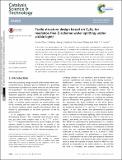Facile structure design based on C3N4 for mediator-free Z-scheme water splitting under visible light
View/
Date
01/06/2015Grant ID
EP/K022237/1
EP/K036769/1
EP/K015540/1
EP/I022570/1
Metadata
Show full item recordAbstract
In this work, two photocatalysts (i.e., C3N4 and WO3) were successfully combined into a heterojunction structure by a facile hydrothermal method for mediator-free overall water splitting, analogous to the natural photosynthesis over a two-step photoexcitation Z-scheme system. Hydrogen and oxygen are evolved with a 2 : 1 ratio by irradiating the C3N4-WO3 composites loaded with Pt under visible light (λ > 420 nm) without any redox mediator. Introducing reduced graphene oxide (rGO) into the C3N4-WO3 composites enhances the water splitting efficiency. Through optimizing the mass ratio in the C3N4-WO3 composites, rGO content, amount of loaded Pt and pH value of the reacting system, the highest H2/O2 evolution rates of 2.84 and 1.46 μmol h−1 can be obtained, with a quantum yield of 0.9%. Our findings demonstrate that the hydrothermal method is a promising strategy for constructing intimate heterostructures for Z-scheme water-splitting systems without using any redox mediator, and that rGO can be used to further enhance the performance in optimized conditions.
Citation
Zhao , G , Huang , X , Fina , F , Zhang , G & Irvine , J T S 2015 , ' Facile structure design based on C 3 N 4 for mediator-free Z-scheme water splitting under visible light ' , Catalysis Science & Technology , vol. 5 , no. 6 , pp. 3416-3422 . https://doi.org/10.1039/C5CY00379B
Publication
Catalysis Science & Technology
Status
Peer reviewed
ISSN
2044-4753Type
Journal article
Description
The authors thank the Engineering and Physical Sciences Research Council (EPSRC) platform grant EP/K006800/1, EP/K036769/1 and EP/K022237/1 for financial support.Collections
Items in the St Andrews Research Repository are protected by copyright, with all rights reserved, unless otherwise indicated.

